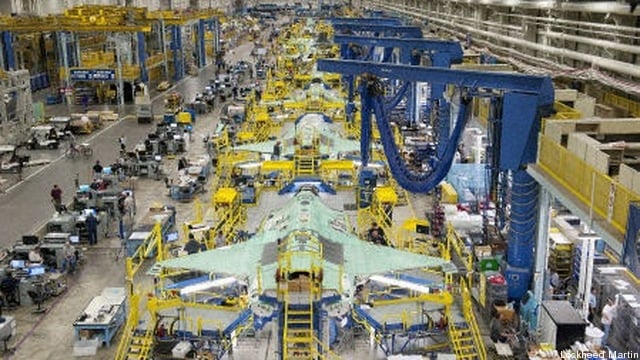AIR FORCE PLANT 4, FORT WORTH: No one should believe that the battle between Boeing and Lockheed for the right to build Navy fighters is over.
Boeing keeps pushing the low cost, readiness and availability of the F-18. It’s here, it’s proven, and, they say, a new F/A-18E/F Super Hornet will cost just over $50 million for a fully equipped airplane, should the Navy decide to buy more.
During a briefing here before the rollout ceremony for the one hundredth Joint Strike Fighter, Lockheed Martin’s direct, articulate, and fittingly named general manager for the JSF, Lorraine Martin, made this bold pledge during a briefing for reporters: By 2019, the F-35A (the Air Force version) will cost $75 million a copy in current dollars ($85 million in good ole then-year dollars, i.e. counting future inflation), which will be “less than any fourth generation fighter in the world.” That means no other fighter already flying (one sold in US dollars or Euros) will cost less — not the famously inexpensive Gripen, not the French Rafale, the Russian MiG-35, the Boeing F-15 Eagle, or the European Typhoon.
And Martin, known for helping to right Lockheed Martin’s most important program — which had been very wobbly — went even further: “I think we can do even better.” Skeptics will, of course, note that her prediction can’t be tested for five years. That’s forever in Pentagon budget terms. In legislative years, it’s not quite as far away — only two elections. Is it marketing? Of course it is. But it’s also a clear sign that Lockheed continues to target the Navy above all other clients.
A battle has brewed inside the Navy and between the Navy and the Office of Secretary of Defense over when the service should start buying F-35Cs and how many it should buy. Most recently, the Navy “goofed” and issued and then withdrew a pre-solicitation offer for up to a mix of up to 36 F-18 Super Hornets and EA-18G Growlers, the radar-jamming variant.
At a Dec. 9 F-18 event, Boeing’s F-18 program manager, Mike Gibbons, said the F-18 Super Hornet costs about $51 million a copy, counting key components — like the engine — that government buys directly from other companies. So how is $75 million less than $51 million, we asked Martin during her briefing here? She told us she was “not sure” the F-18 price included “everything on it,” while the F-35 price includes all weapon systems. We tried to get a better answer but failed.
Fundamentally, Boeing’s case is fairly weak because cutting the number of F-35s would significantly raise the politically sensitive unit price. And Frank Kendall, head of Pentagon acquisition, and other senior defense officials have made clear for months now that they are trying to do everything they can to keep the JSF price and program costs as low as possible. They also have made clear that their commitment to the F-35 is rock solid as the program has stabilized and cut costs. One factor that will be difficult for Boeing to counter is the allies’ hunger for the F-35’s costs to remain as low as possible.
So, while elements of the Navy really, really want to buy more F-18s (Super Hornets and/or Growlers), the service is split. Combine that with the commitment to the program by the senior Pentagon leadership and a host of allies, and I think Boeing faces an uphill battle — and uphill battles in the Pentagon are rarely won. (Sorry, Rep. Forbes!)
(Full disclosure: Lockheed Martin picked up the tabs for our flight to Fort Worth and hotel. Added this Dec. 19 as I forgot to append. The Editor)
In a ‘world first,’ DARPA project demonstrates AI dogfighting in real jet
“The potential for machine learning in aviation, whether military or civil, is enormous,” said Air Force Col. James Valpiani. “And these fundamental questions of how do we do it, how do we do it safely, how do we train them, are the questions that we are trying to get after.”



























